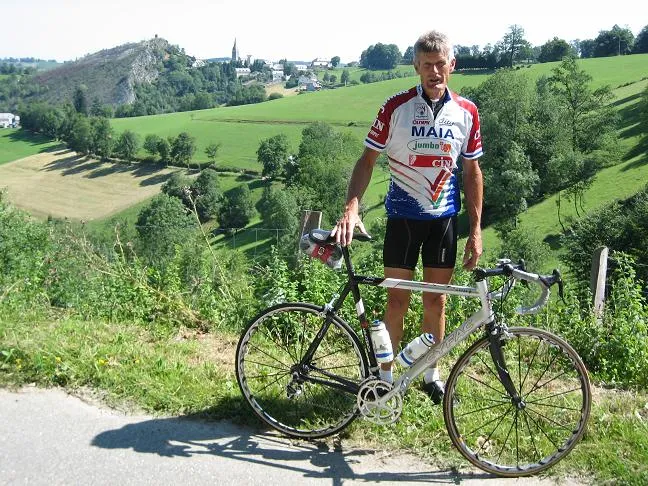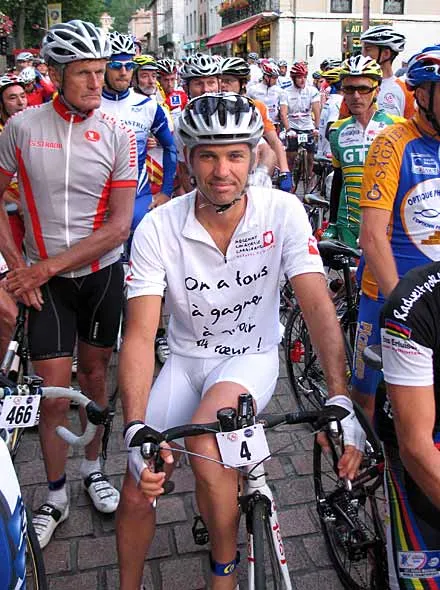L'Etape du Tour is an annual event that gives amateur riders and racers a chance to experience a stage of the Tour de France, and since 1993, the field has ballooned from 1,705 to 8,500 riders. Retired commercial airline pilot Lindsay Crawford, 66, is a Northern California racer who also won his category in 2003. Here he describes the route, and his preparations leading up to the July 6 event. Make sure to read his account of his 2007 L'Etape below, with a certain American Tour winner pushing the pace.
Most of the articles I have read regarding L’Etape du Tour have been by participants that are there with the goal of completing the event before the cutoff time, but not entering it as a race, which it is for a fair number of riders.
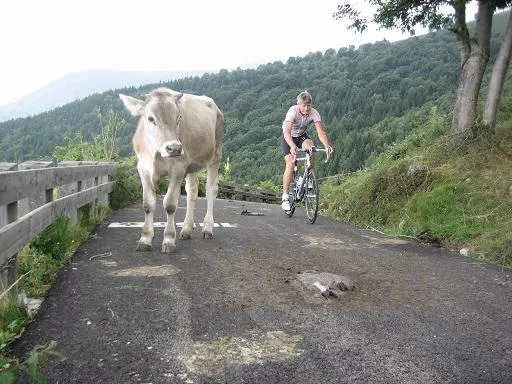
Having won my category in 2003 (but not trying to sound elitist), I thought writing about what's it's like near the front with the faster riders might be interesting to some readers.
Numerous blogs and forums have appeared recently, so anyone can find a tremendous amount of information down to the minutest detail about L’Etape du Tour. My approach is considerably less detailed; I need to know when and where the start is, what cols are included and where is the finish. I’m an old-school rider that doesn’t train with a heart-rate monitor or power meter, and I don’t have a coach.
My preparations
I’ll be riding L'Etape du Tour for the seventh time and, as usual, the day after the 2008 route was announced I made hotel reservations close to the finish. Then it was time to come up with a plan to be ready on July 6th for a great event.
Training started in mid January with many long base mile rides, and because of a fairly mild, though wet, winter in Northern California I only rode the indoor trainer once this past winter. When I head out in the rain, I remember the old saying: “you’ll never be able to tell your grandchildren about an epic turbo trainer ride but you will be able to tell them about an epic ride in difficult conditions.”
I also try to join a local group, that usually includes some pros and Category I riders, every Wednesday for a moderately hard ride of five to six hours. For the past six years, as part of my preparation, I raced two back-to-back stage races: La Vuelta de Bisbee in Arizona and The Tour of the Gila in New Mexico. This year the Tour of the Gila didn’t go as planned when I crashed just 14 miles into the first of five stages. I received more than my share of road rash but, otherwise was okay. Checking my records, I found the last time I crashed in a race was a criterium in May of 1980! I guess it was time.
Through the spring, I put in many mid 20-hour weeks on the bike and rode one more race, a local classic in Northern California known as Mt. Hamilton. I always race down in the age groupers to get in the longer distances at a high intensity and have to resign myself to usually a mid-pack placing. For me, I believe hours and hours of hard riding is the right training for a good placing in L’Etape du Tour.
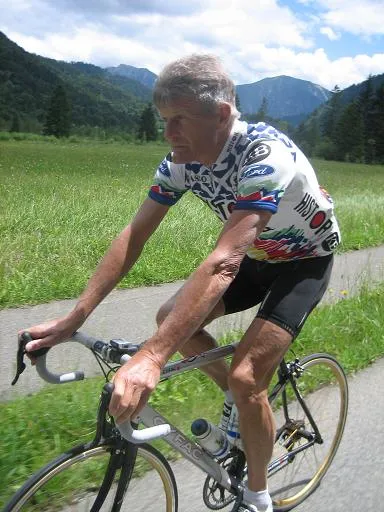
Long winter base miles occasionally include something different for variety. Procycling Magazine contributor Bruce Hildenbrand and I made several excursions onto dirt roads and fire trails, exploring the coastal hills of Northern California. Yes, we do it on road bikes and have been doing so since long before mountain bikes were invented. Plus, dirt road riding is good training for L'Eroica, which I rode last October.
The route
This year the L'Etape's first 100km will be short rolling climbs from Pau to Ste. Marie de Campan, where Eugene Christophe repaired his broken fork during the 1913 Tour de France. Right turn, and then we climb the Tourmalet. Over the top and a fast 19km descent to Luz Saint Sauveur. Another right turn down through Gorge de Luz and up the Hautacam to the finish.
This year because of limited space at the finish, refreshments and awards will be at the base of the Hautacam in Lau Balagnas. Three hundred signs and 60 marshals will keep the final 14km separated for riders climbing to the finish and others descending to Lau Balagnas.
For 2008, I’ll be riding two more cyclo-sportives while in Europe. I’m in Spain racing the Quebrantahuesos June 21, then the L'Ariegeoise June 28. Both events are part of the International Cycling Union (UCI) Golden Bike series. By the finish of L’Etape du Tour, I’ll have quite a few miles in the Pyrenees for the year.
For those reading this and riding L’Etape du Tour 2008, I wish you a good ride and hope you reach your goal, whether it’s for the Gold, Silver or Bronze!
Some interesting statistics for L’Etape du Tour 2008:
8,500 participants: 212 women, 8,288 men.
Men
Category A: 18-29 years old - 505
Category B: 30-39 years old - 1,790
Category C: 40-49 years old - 2,817
Category D: 50-59 years old - 2,285
Category E: 60 years old - 891
Women
Category F: to 35 years old - 38
Category G: 35 years old - 174
Foreign participants: 3,300
Top 10 countries represented:
1. France
2. United Kingdom
3. United States
4. Ireland
5. Australia
6. Switzerland
7. The Netherlands
8. Belgium
9. Canada
10. Spain
2007: An unexpected challenge
Unfortunately, four days before the 2007 L’Etape du Tour, I came down with an intestinal bug and the end result was becoming severely dehydrated. After 24 hours of rest, I was back on the bike and attempting to rehydrate my body. Picked up entry pack with transponder and race number in Foix two days before the start and changed hotels to one just 15km from the finish in Loudenvielle where I met Ben Atkins, UK editor for Cyclingnews. Next day I rode to the top of the Pyresourde to reconnoiter the final kilometres of L’Etape.
Ben and I met in the parking lot of our hotel to drive 160 kms to the start in Foix. About 10 km from Foix we’re stopped by the local police at a road block to keep all traffic out of the city. Lucky for me, Ben was there because with my limited French, I would probably still be there trying to explain my position to the police.
Finally, we were allowed to proceed to the next checkpoint at the edge of the city. Much easier this time and we were on our way, in a minute, in search of a place we could park the car for about 36 hours. Parked, unloaded our bikes, pumped tires, loaded up pockets with food and rode to the start. Staked out our spot inches from the start line about an hour and a half before start time, sat down in the road and dined on extra food we had for topping off prior to the start.
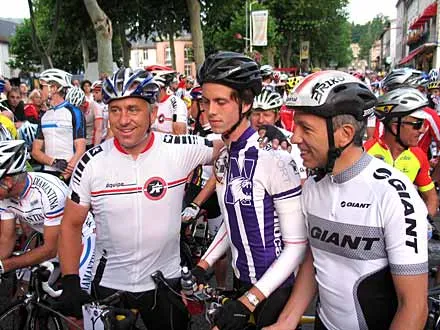
Greg LeMond was the featured rider (with #1 on his jersey) last year and arrived at the start with his oldest son Geoffrey, moments before start time surrounded by the press.

Almost immediately, were moving at close to 50 kph as we leave town. Before long, I was within a couple of riders from the front and guess who I saw as one of the instigators of the high speed – LeMond! Good brisk pace up the Ariége River valley and a right turn to climb the Col de Port. Long fast descent to St Girons and the second climb of the day, the Col de Portet d’ Aspet. Cycling fans will know the descent of the Aspet as where, in 1995, 1992 Olympic road champion and Motorola pro Fabio Casartelli had his fatal crash.
The descent was fast but not too technical, with one stretch at 17 percent. Almost immediately the road heads up again to the Col de Menté. At this point, I’m feeling good and looking for a good time well within the Gold standard. Maybe the intestinal bug four days ago wasn’t that bad, I thought.
Well those thoughts didn’t last too long. About half way up the Menté, I started to feel the beginning of cramps in my quads. Pressed on over the top, quick descent, and hard chase to join a fairly large group ahead as we speed down the valley before the most difficult climb of the day – Port de Balès. Able to sit in with my group of riders on the early two- to four-percent climb and it all went bad as the gradient increased toward ten-percent-plus. Severe cramps set in and ultimately I was unable to turn the pedals. So much for making the Gold or Silver standard!
Walking has never been part of my riding but only two choices were available, I had to walk or give up and sit on the side of the road. Combination of walking and very painful slow riding got me up and over the top. Descent to the Vallée d’Oueil was with both feet hanging straight down off the pedals. Right turn at the bottom and the start of the final climb, the Peyresourde. About two pedal strokes and legs locked up again. Off the bike and pressed on afoot. With about 9 km to the top and my walking at 4 kph didn’t look too promising, at the time, and I actually considered quitting until I realized I would probably sit on the side of the road at least four hours waiting for the broom wagon.
As I’m walking and trying to figure out how all of this is going to end, an angel in the form of a local citizen appeared alongside with a bowl of salt crystals. He said 'take this for your cramps.' I grabbed a handful of salt, mixed it with the water in my bottle and immediately drank half of it. After a few more steps I was able to get back on the bike to work my way up the mountain by standing to pedal with my knees out (alleviated the severe pain in the inner quads) and in my bottom gear. I was so far gone by the time my “angel” arrived that decent recovery was not possible but at least it allowed me to continue.
Eventually, I got over the top and descended quickly to the finish. Certainly not how I expected it to be but glad to have ridden my sixth L’Etape du Tour, finishing in 651st place in eight hours, 36 minutes.
Returning home and talking to a couple of medical professionals, I was told that the only way I could have recovered from my intestinal bug in time for L’Etape would be with an IV to replace the fluid and minerals that were lost.
Yes, Greg LeMond rode the distance. Climbing the Peyresourde, I could easily tell where he was by the noise made by his fans as he rode past. Admired by the French, he is still surrounded by autograph seekers and photographers.
Check back for Lindsay's post-L'Etape report in mid July.
